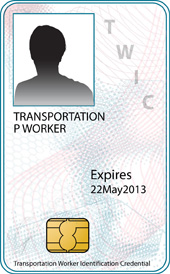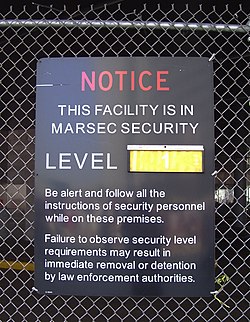
The United States Coast Guard (USCG) is the maritime security, search and rescue, and law enforcement service branch of the United States Armed Forces and one of the country's eight uniformed services. The service is a maritime, military, multi-mission service unique among the United States military branches for having a maritime law enforcement mission with jurisdiction in both domestic and international waters and a federal regulatory agency mission as part of its duties. It is the largest coast guard in the world, rivaling the capabilities and size of most navies.
Homeland security is an American national security term for "the national effort to ensure a homeland that is safe, secure, and resilient against terrorism and other hazards where American interests, aspirations, and ways of life can thrive" to the "national effort to prevent terrorist attacks within the United States, reduce the vulnerability of the U.S. to terrorism, and minimize the damage from attacks that do occur." According to an official work published by the Congressional Research Service in 2013, the "Homeland security" term's definition has varied over time.

The United States Department of Homeland Security (DHS) is the U.S. federal executive department responsible for public security, roughly comparable to the interior or home ministries of other countries. Its stated missions involve anti-terrorism, border security, immigration and customs, cyber security, and disaster prevention and management.

In the United States, the Homeland Security Advisory System (HSAS) was a color-coded terrorism threat advisory scale created in March 2002 under the Bush administration in response to the September 11 attacks. The different levels triggered specific actions by federal agencies and state and local governments, and they affected the level of security at some airports and other public facilities. It was often called the "terror alert level" by the U.S. media. The system was replaced on April 27, 2011, with a new system called the National Terrorism Advisory System.

The Homeland Security Act (HSA) of 2002, was introduced in the aftermath of the September 11 attacks and subsequent mailings of anthrax spores. The HSA was cosponsored by 118 members of Congress. The act passed the U.S. Senate by a vote of 90–9, with one Senator not voting. It was signed into law by President George W. Bush in November 2002.

A Maritime Safety and Security Team, or MSST, is a counter-terrorism team of the United States Coast Guard established to protect local maritime assets. It is also a harbor and inshore patrol and security team that includes detecting and, if necessary, stopping or arresting submerged divers, using the Underwater Port Security System. It is the only special force that can arrest submerged divers.

Air and Marine Operations (AMO) is a federal law enforcement component within U.S. Customs and Border Protection (CBP), an agency of the United States Department of Homeland Security (DHS). AMO's mission is to protect the American people and nation's critical infrastructure through the coordinated use of air and marine assets to detect, interdict and prevent acts of terrorism and the unlawful movement of people, illegal drugs, and other contraband toward or across the borders of the United States. Air and Marine Operations Agents and Officers are endowed with the authority to enforce Title 8 and Title 19 (Customs) of the United States Code in addition to the general law enforcement powers bestowed upon federal law enforcement agents.

Coast Guard Intelligence (CGI) is the military intelligence branch of the United States Coast Guard, and a component of the Central Security Service of the United States Department of Defense.

The Transportation Worker Identification Credential program is a Transportation Security Administration (TSA) and U.S. Coast Guard initiative in the United States. The TWIC program provides a tamper-resistant biometric credential to maritime workers requiring unescorted access to secure areas of port facilities, outer continental shelf facilities, certain manufacturing facilities, and vessels regulated under the Maritime Transportation Security Act of 2002, or MTSA, and all U.S. Coast Guard credentialed merchant mariners. As of May 2014, there were 2,999,058 people enrolled in the program. Those seeking unescorted access to secure areas aboard affected vessels, and all Coast Guard credentialed merchant mariners, must obtain a TWIC. The new measures were fully implemented on April 15, 2009. To obtain a TWIC, an individual must provide biographic and biometric information such as fingerprints, sit for a digital photograph and successfully pass a security threat assessment conducted by TSA.

Port security is part of a broader definition concerning maritime security. It refers to the defense, law and treaty enforcement, and Counterterrorism activities that fall within the port and maritime domain. It includes the protection of the seaports themselves and the protection and inspection of the cargo moving through the ports. Security risks related to ports often focus on either the physical security of the port, or security risks within the maritime supply chain.
Maritime security is concerned with the prevention of intentional damage through sabotage, subversion, or terrorism. Maritime security is one of the three basic roles of the United States Coast Guard has gradually developed in response to a series of catastrophic events, which began in 1917.
Terror alert systems are standardised emergency population warning systems for describing and disseminating information about terrorism-related threats. They became more popular after the September 11 attacks on the United States in 2001.
Sector Commander is the position title of the commanding officer of a United States Coast Guard Sector, usually of the rank of Captain (O-6). The Sector Commander's second-in-command is the Deputy Sector Commander. Also reporting directly to the Sector Commander are the Command Master Chief (CMC), the Senior Reserve Officer, and the Sector's Auxiliary Coordinator.

Sensitive security information (SSI) is a category of United States sensitive but unclassified information obtained or developed in the conduct of security activities, the public disclosure of which would constitute an unwarranted invasion of privacy, reveal trade secrets or privileged or confidential information, or be detrimental to the security of transportation. It is not a form of classification under Executive Order 12958 as amended. SSI is not a security classification for national security information. The safeguarding and sharing of SSI is governed by Title 49 Code of Federal Regulations (CFR) parts 15 and 1520. This designation is assigned to information to limit the exposure of the information to only those individuals that "need to know" in order to participate in or oversee the protection of the nation's transportation system. Those with a need to know can include persons outside of TSA, such as airport operators, aircraft operators, railroad carriers, rail hazardous materials shippers and receivers, vessel and maritime port owners and operators, foreign vessel owners, and other persons.
A Sector is a shore-based operational unit of the United States Coast Guard. Each Sector is responsible for the execution of all Coast Guard missions within its Area of Responsibility (AOR), with operational support from Coast Guard Cutters and Air Stations. Subordinate commands within a Sector typically include Stations and Aids-to-Navigation (ATON) Teams. Some Sector commands also have subordinate units such as Sector Field Offices and Marine Safety Units that are responsible for mission execution in parts of the Sector's AOR. There are 37 sectors within the Coast Guard.

The Chemical and Biological Defense Division (CBD) is a division of the Science and Technology Directorate of the United States Department of Homeland Security. Within the Homeland Security Advanced Research Projects Agency, CBD develops technologies to increase the United States's preparedness and protect key national infrastructure against chemical, biological, and agricultural threats and disasters through improved threat awareness and advanced surveillance, detection, and protective countermeasures.
In the United States, border security includes the protection of ports, airports, and the country's 3,017-mile (4,855 km) land border with Canada and 1,933-mile (3,111 km) border with Mexico.

The Deployable Specialized Forces (DSF) —formerly Deployable Operations Group— are part of the United States Coast Guard that provide highly equipped, trained and organized deployable specialized forces, to the Coast Guard, United States Department of Homeland Security (DHS), United States Department of Defense (DoD) and inter-agency operational and tactical commanders. The command was formerly headquartered in Arlington, Virginia where it was established on 20 July 2007, and was commanded by a captain. It was decommissioned by the Commandant of the Coast Guard, Admiral Robert Papp on 1 October 2013, with units previously assigned to the DOG being split between Coast Guard Pacific and Atlantic Area commands. The units were subsequently reorganized under Deployable Specialized Forces (DSF).

The National Terrorism Advisory System (NTAS) is a terrorism threat advisory scale used by the US Department of Homeland Security since April 26, 2011.

A Visible Intermodal Prevention and Response team, sometimes Visible Intermodal Protection and Response (VIPR) is a Transportation Security Administration program. Various government sources have differing descriptions of VIPR's exact mission. It is specifically authorized by 6 U.S.C. § 1112 which says that the program is to "augment the security of any mode of transportation at any location within the United States". Authority for the program is under the Secretary of Homeland Security. The program falls under TSA's Office of Law Enforcement/Federal Air Marshal Service. TSA OLE/FAMS shares responsibility for the program with the Office of Security Operations and Transportation Sector Network Management.













